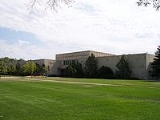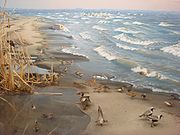
Royal Saskatchewan Museum
Encyclopedia
The Royal Saskatchewan Museum was established in Regina
as the Provincial Museum in 1906 to "secure and preserve natural history specimens and objects of historical and ethnological interest." It was the first museum in Saskatchewan
, Canada, and the first provincial museum in the three Prairie Provinces.
 Between 1906 and 1945 the Museum occupied several premises including the Regina Trading Company Building, the Provincial Legislative Building, and the Normal School (the eastern-most historic building on the "College Avenue" campus of the University of Regina
Between 1906 and 1945 the Museum occupied several premises including the Regina Trading Company Building, the Provincial Legislative Building, and the Normal School (the eastern-most historic building on the "College Avenue" campus of the University of Regina
). During the Second World War
the Museum's collections were taken out of public display and stored initially in the General Motors Building (east on Dewdney Avenue) to permit the Normal School to be used for the Commonwealth Air Training Plan, and then, when the GM building was also requisitioned, in Pilkington’s Glass Company Building. The collections returned to the Normal School in 1944 and opened to the public again in 1946.
Finally the provincial government built the current premises on the corner of Albert Street and College Avenue, the site of the abandoned Chateau Qu'Appelle
Hotel, as a Saskatchewan Golden Jubilee project. Partly for aesthetic reasons and partly to avoid the expansive task of uprooting the pilings, the museum was built on an angle with a large front lawn. The new premises were opened by Governor General Vincent Massey
on May 16, 1955. To reflect the areas of devotion, the museum adopted a new title "Saskatchewan Museum of Natural History". This title stuck until 1993 when they received royal designation from Queen Elizabeth II, Queen of Canada
and became the Royal Saskatchewan Museum.
The Museum collection, then housed in the provincial legislative building, had been decimated by the 1912 "Regina Cyclone
." The collection was severely damaged again in 1990 when fire broke out in the First Nations Gallery, which was then under construction. Smoke damage required the museum to close for four months; and many areas remained closed for years. Since the fire, the First Nations
Gallery and the Life Sciences have been substantially improved.
, the Canadian Heritage Information Network
, and the Virtual Museum of Canada
.
Regina, Saskatchewan
Regina is the capital city of the Canadian province of Saskatchewan. The city is the second-largest in the province and a cultural and commercial centre for southern Saskatchewan. It is governed by Regina City Council. Regina is the cathedral city of the Roman Catholic and Romanian Orthodox...
as the Provincial Museum in 1906 to "secure and preserve natural history specimens and objects of historical and ethnological interest." It was the first museum in Saskatchewan
Saskatchewan
Saskatchewan is a prairie province in Canada, which has an area of . Saskatchewan is bordered on the west by Alberta, on the north by the Northwest Territories, on the east by Manitoba, and on the south by the U.S. states of Montana and North Dakota....
, Canada, and the first provincial museum in the three Prairie Provinces.
History

University of Regina
The University of Regina is a public research university located in Regina, Saskatchewan, Canada. Founded in 1911 as a private denominational high school of the Methodist Church of Canada, it began an association with the University of Saskatchewan as a junior college in 1925, and was disaffiliated...
). During the Second World War
World War II
World War II, or the Second World War , was a global conflict lasting from 1939 to 1945, involving most of the world's nations—including all of the great powers—eventually forming two opposing military alliances: the Allies and the Axis...
the Museum's collections were taken out of public display and stored initially in the General Motors Building (east on Dewdney Avenue) to permit the Normal School to be used for the Commonwealth Air Training Plan, and then, when the GM building was also requisitioned, in Pilkington’s Glass Company Building. The collections returned to the Normal School in 1944 and opened to the public again in 1946.
Finally the provincial government built the current premises on the corner of Albert Street and College Avenue, the site of the abandoned Chateau Qu'Appelle
Chateau Qu'Appelle
The Chateau Qu'Appelle was a Grand Trunk Pacific Railway hotel planned for Regina, Saskatchewan. Construction was started in 1913 at the corner of Albert Street and 16th Avenue . Rising costs, labour and material shortages, and the bankruptcy of the railway stopped the project before it was completed...
Hotel, as a Saskatchewan Golden Jubilee project. Partly for aesthetic reasons and partly to avoid the expansive task of uprooting the pilings, the museum was built on an angle with a large front lawn. The new premises were opened by Governor General Vincent Massey
Vincent Massey
Charles Vincent Massey was a Canadian lawyer and diplomat who served as Governor General of Canada, the 18th since Canadian Confederation....
on May 16, 1955. To reflect the areas of devotion, the museum adopted a new title "Saskatchewan Museum of Natural History". This title stuck until 1993 when they received royal designation from Queen Elizabeth II, Queen of Canada
Elizabeth II of the United Kingdom
Elizabeth II is the constitutional monarch of 16 sovereign states known as the Commonwealth realms: the United Kingdom, Canada, Australia, New Zealand, Jamaica, Barbados, the Bahamas, Grenada, Papua New Guinea, the Solomon Islands, Tuvalu, Saint Lucia, Saint Vincent and the Grenadines, Belize,...
and became the Royal Saskatchewan Museum.
The Museum collection, then housed in the provincial legislative building, had been decimated by the 1912 "Regina Cyclone
Regina Cyclone
The Regina Cyclone is the popular name for a tornado that devastated the city of Regina, Saskatchewan, Canada on June 30, 1912. At about 4:50 p.m., green funnel clouds formed and touched down south of the city, tearing a swath through the residential area between Wascana Lake and Victoria Avenue...
." The collection was severely damaged again in 1990 when fire broke out in the First Nations Gallery, which was then under construction. Smoke damage required the museum to close for four months; and many areas remained closed for years. Since the fire, the First Nations
First Nations
First Nations is a term that collectively refers to various Aboriginal peoples in Canada who are neither Inuit nor Métis. There are currently over 630 recognised First Nations governments or bands spread across Canada, roughly half of which are in the provinces of Ontario and British Columbia. The...
Gallery and the Life Sciences have been substantially improved.
Affiliations
The museum is affiliated with the Canadian Museums AssociationCanadian Museums Association
The Canadian Museums Association is a national organization for the promotion of museums in Canada.The Canadian Museums Association is the national organization for the advancement of the Canadian museum sector, representing Canadian museum professionals both within Canada and internationally. The...
, the Canadian Heritage Information Network
Canadian Heritage Information Network
The Canadian Heritage Information Network is a Canadian government-supported organization that provides a networked interface to Canada's heritage, largely through the World Wide Web. It aims to give access to Canada's heritage for both Canadians and a worldwide audience, by supporting the...
, and the Virtual Museum of Canada
Virtual Museum of Canada
The Virtual Museum of Canada is Canada's national virtual museum. With a directory of over 3,000 Canadian heritage institutions and a database of over 600 virtual exhibits, the VMC brings together Canada's museums regardless of size or geographical location.The VMC includes virtual exhibits,...
.
External links
- Royal Saskatchewan Museum website
- Saskatchewan Royal Connections

